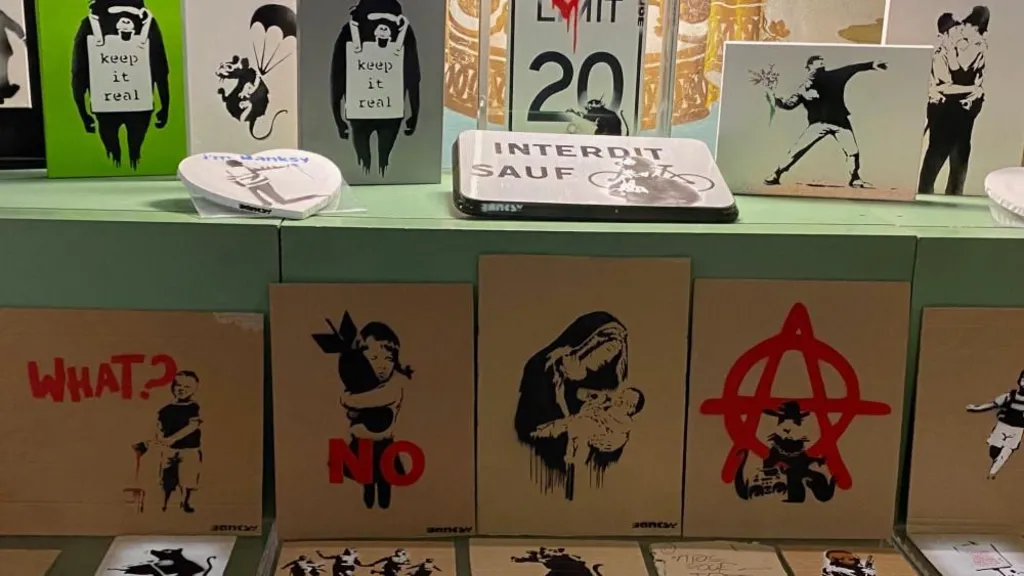Italian authorities have dismantled a major European criminal network responsible for forging and selling counterfeit artworks by some of the most renowned artists in modern history, including Banksy, Andy Warhol, and Pablo Picasso. More than 2,100 forged pieces were seized in a series of coordinated raids across multiple countries, and 38 individuals were arrested for their involvement in the operation, which authorities estimate could have generated around €200 million (£165 million; $213 million) in illicit sales.
The bust, which uncovered six separate forgery workshops, highlights the scale of the operation. Two of the workshops were based in Tuscany, while others were located in Venice and various locations across Europe. The forgeries targeted not only works by Banksy, Warhol, and Picasso, but also pieces attributed to other iconic artists, including Claude Monet, Vincent Van Gogh, Salvador Dalí, Joan Miró, Jackson Pollock, Henry Moore, Francis Bacon, Gustav Klimt, and Piet Mondrian.
The network was uncovered after a tip-off in 2023, when Italian police seized around 200 fake artworks from a businessman’s collection in Pisa. Among the fakes was a counterfeit drawing attributed to Italian artist Amedeo Modigliani. Investigators later expanded their search to other European countries, resulting in raids in Italy, Spain, and Belgium, where more forgeries were recovered.
The criminal ring is accused of conspiracy to handle stolen goods, forgery, and the illegal sale of art. The Carabinieri cultural squad and the Pisa prosecutors’ office, which led the operation, described it as one of the largest art fraud busts in recent years. “This is the biggest act of protection of Banksy’s estate,” said Pisa Chief Prosecutor Teresa Angela Camelio, underscoring the importance of the seizure in preserving the integrity of the artist’s work.
Banksy, whose true identity remains officially unknown, is one of the world’s most famous and elusive contemporary artists. His works, often created using street art techniques on public buildings, have long been a target for forgers and criminals. This is not the first time Banksy’s art has been at the center of a criminal case. In September, two thieves were arrested for stealing his iconic Girl with Balloon artwork from a gallery in central London. Banksy’s pieces, often valued for their unique presence in public spaces, are vulnerable to defacement and theft, as evidenced by a recent series of incidents where his Urban Jungle collection was defaced in London.
Similarly, Warhol’s works have also been targeted by criminals in recent months. In early October, two of his artworks were stolen during a break-in at a gallery in the Netherlands. Warhol’s popular pop art style, particularly his portraits of celebrities and everyday consumer items, remains highly sought after in both the art world and the illicit market.
The seizure of over 2,100 forged artworks is part of a wider crackdown on art-related crime across Europe. Authorities have warned that art forgeries represent a significant threat to the cultural heritage and integrity of the art market, often deceiving collectors and investors. In many cases, buyers unknowingly purchase fakes that are sold at prices equivalent to genuine works.
The ongoing investigation is expected to reveal more about the scale of the forgery operation and the international network involved in trafficking counterfeit art. Experts involved in the investigation have noted that many of the forgeries were of exceptionally high quality, making them difficult for the average buyer to distinguish from genuine works. Authorities have urged art collectors and dealers to exercise caution and ensure that any artwork they acquire comes with proper authentication.
While art forgery has long been a problem, the case in Italy is a stark reminder of the ways in which criminals exploit the global art market for profit. With more than 30 well-known artists affected, this case is one of the most significant art fraud busts in recent years. The involvement of multiple European countries highlights the international nature of art crime and the need for greater collaboration between law enforcement agencies.
The dismantling of this forgery ring has been hailed as a major victory for the protection of the art world and its cultural treasures. As investigations continue, authorities remain focused on disrupting art-related crime and ensuring that the public can continue to enjoy authentic works of art without the fear of forgeries undermining their value.
This case also underscores the vulnerability of both high-profile and lesser-known artists to exploitation by criminals. With works by iconic figures such as Picasso and Banksy at the heart of the scam, this operation serves as a warning to the art world of the need for vigilance and stricter measures to combat art fraud.






